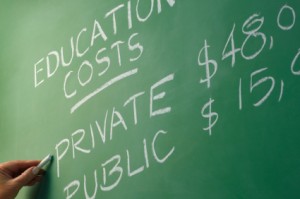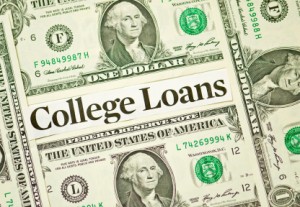College Admissions
College Admissions
Preparing for College
The Best College for You
What to Study
Applications
Education Options
Education Options
Private Universities
Public & State Universities
Community Colleges
Scholarships
Scholarships
African American Scholarships
Latino Scholarships
Native American Scholarships
Women Scholarships
College Grants
College Grants
Federal Grants
Merit Based Grants
Need Based Grants
Student Loans
Student Loans
Federal Student Loans
State Student Loans
No Co-signer Student Loans
Bad Credit Loans
Student Loan Consolidation
College Survival
College Survival
Financial Aid Tips
The Digital Student Blog
All federal loans set to follow the Direct Loan program format.
Lost in all the hype over the passage of the landmark health care bill was a provision in the bill to revamp the federal student loan program. The legislation will put an end to the popular FFEL Program and thus push all federal college loans into the Direct Loan format.
The FFEL and DL Programs
 The Federal Family Education Loan Program (“FFEL Program” or “FFELP”) is often referred to as the federally guaranteed student loan program. In FY 2008, approximately 75% of all colleges participated in this lending option.
The Federal Family Education Loan Program (“FFEL Program” or “FFELP”) is often referred to as the federally guaranteed student loan program. In FY 2008, approximately 75% of all colleges participated in this lending option.
As opposed to the loans originating from the federal government, in the FFEL program the loan funds come from banks and other financial institutions. Because of the large number of entities offering such loans, colleges participating in the FFEL program were able to maximize borrower choice.
In addition, the FFEL program offered the same set of loan options as the Direct Loan program: Stafford, PLUS and Consolidation loans.
Funds for the William D. Ford Federal Direct Loan Program (“Direct Loans” Program or “DLP”) come directly from the US Department of Education (which gets the funds from the US Treasury). Because of the funding source, this source of aid has not experienced the same funding issues as FFELP has during the current credit crisis.
Program Differences
Critical differences have begun emerging within the two programs. First, as noted above, as the credit crisis worsened and banks tightened their lending practices, less money was available to students in the form of FFELP loans. In contrast, DLP loans remained available.
Unfortunately, the Ensuring Continued Access to Student Loans Act of 2008 (ECASLA) did not address funding issues in all loan programs, just the Stafford and PLUS loan programs. The indirect result was that consolidation loans originating after October 1, 2007 became unprofitable for FFEL program lenders. Because of that development, most of the FFELP lenders have stopped offering consolidation loans.
In contrast, consolidation loans continued to remain available from the Direct Loan program but borrowers in the FFEL program generally could only consolidate their loans by moving into the Direct Loan program.
Two other major differences tend to make the Direct Loan option a better one for students. First, the interest rate on the PLUS loan maxes out at 8.5% in the FFEL Program. For the Direct Loan program, the maximum rate tops out at 7.9% for the PLUS. However, the interest rate on the Stafford Loan is identical in both programs.
 Independent analysis has revealed that parents are more likely to obtain a PLUS loan approval in the Direct Loan program than in the FFEL program. The 2007-08 National Postsecondary Student Aid Study (NPSAS) suggests that the Parent PLUS loan denial rate in the FFEL program in 2007-08 was double the Parent PLUS loan denial rate in the Direct Loan program.
Independent analysis has revealed that parents are more likely to obtain a PLUS loan approval in the Direct Loan program than in the FFEL program. The 2007-08 National Postsecondary Student Aid Study (NPSAS) suggests that the Parent PLUS loan denial rate in the FFEL program in 2007-08 was double the Parent PLUS loan denial rate in the Direct Loan program.
Lastly, the new Public Service Loan Forgiveness option is available to students only in the Direct Loan program.
Customer Service Impact for Students
On the plus side, according to the Congressional Budget Office estimates, eliminating the middleman from the loan process will save the federal government between $6 billion and $7 billion per year. Those savings are reportedly possible because the government has paid private banks billions of dollars in subsidies to encourage those institutions to loan to students.
On the negative side, the changes will result in the loss of a number of valuable agencies.
But for most college students, the major question centers upon how the legislation affects them and their families. The answer is that it will impact students according to their financial status.
 An enormous increase this year in Pell grants was set to create a major shortfall in fund for many low-income students. The legislative change ensures that the Pell grant program will not only remain solvent, it will provide annual increases in the maximum grant allocation for the foreseeable future.
An enormous increase this year in Pell grants was set to create a major shortfall in fund for many low-income students. The legislative change ensures that the Pell grant program will not only remain solvent, it will provide annual increases in the maximum grant allocation for the foreseeable future.
Second, the funding level for students will be more secure. Therefore, those students who recently found loans drying up during the fiscal crisis will now know that such funds will remain available.
Lastly, the legislation will do nothing to negatively impact existing loans including private loans. But for those individuals who later qualify for the Income-Based Repayment Program, the capped rate will drop from 15% to 10% of discretionary income and shorten the repayment window from 25 to 20 years.
In actuality, the greatest impact will be felt with the school’s financial aid officers. One critical outcome is that those individuals will no longer play a role in which private lenders are used to originate those loans for students.
But of course, at this point, only the House has approved the bill. The Senate is scheduled to take up the bill later in the week.
There is a great deal of hope among college basketball fanatics for a KU vs. UK NCAA Final in 2010. For those not in the know, KU is Kansas University, the number one overall seed in the tournament. UK is the University of Kentucky, the team with the best overall player in freshman John Wall.
But I for one am hoping for a different result. I am hoping that Kentucky gets banished quickly for more reasons than the man who was hired to coach the team.
 Each year, Derrick Z. Jackson, an African-American editorial writer for the Boston Globe, takes the time to scrub the NCAA graduation data. He is not easily fooled by the likes of the National Collegiate Athletic Association interim president Jim Isch who earlier this year implied that the NCAA emphasis on academics had helped raise the overall graduation rate for college basketball nearly 10 percentage points over the last eight years.
Each year, Derrick Z. Jackson, an African-American editorial writer for the Boston Globe, takes the time to scrub the NCAA graduation data. He is not easily fooled by the likes of the National Collegiate Athletic Association interim president Jim Isch who earlier this year implied that the NCAA emphasis on academics had helped raise the overall graduation rate for college basketball nearly 10 percentage points over the last eight years.
Those rooting for a Kansas-Kentucky final should look at some of the data Jackson has uncovered. First off, he notes that Kentucky cannot really boast of academics at all, not with a basketball Graduation Success Rate of just 18 percent for its black athletes. And not when its GSR for basketball is but 31 percent overall.
In fact, Jackson did some extensive digging and found that Kentucky’s graduation rate for its black players over the last six years tops out at 18%. The five other years the school posted black graduation rates of 17, 9, 17, 17, and zero. And just to clarify that he is not cherry picking, going back ten years the black player graduation rate has never risen above 29 percent.
It is important to recognize that these rates do not reflect the all-too-often explanation offered by sports junkies – that these top programs post poor rates simply because their athletes leave early for pro basketball. The fact is, the NCAA adjusts these graduation-rate reports for those players leaving a school, for pro basketball or for another school, as long as those athletes were in good academic standing at the time they made the move.
So you will not find me rooting for Kentucky to make it to the finals. Especially not with a coach who has twice left programs that have had their accomplishments rescinded because of rule infractions.
In addition, I no longer can root for Duke, a school that does graduate its players yet accepts athletes to fill out its athletic rosters that do not have the requisite SAT scores or academic qualifications that non-athletes must have to be accepted at the school.  If you care about the idea that the NCAA tournament is supposed to involve amateurs enrolled in a college, then you will not root for Maryland (a zero black graduation rate the past three years and 8 percent currently overall), Texas (black graduation rates the past three years of 29, 14 and 22 percent), Nevada Las Vegas (black player grad rates of 13, 10, 10, 14, and 17 percent the last five years), or the University of California at Berkeley (a GSR for both its black and white players of zero – as opposed to the overall campus graduation rate of 85 percent (62 percent for black students). Other teams that stretch the term student-athlete beyond recognition are New Mexico State, Washington, Missouri, Arkansas-Pine Bluff, and Baylor.
If you care about the idea that the NCAA tournament is supposed to involve amateurs enrolled in a college, then you will not root for Maryland (a zero black graduation rate the past three years and 8 percent currently overall), Texas (black graduation rates the past three years of 29, 14 and 22 percent), Nevada Las Vegas (black player grad rates of 13, 10, 10, 14, and 17 percent the last five years), or the University of California at Berkeley (a GSR for both its black and white players of zero – as opposed to the overall campus graduation rate of 85 percent (62 percent for black students). Other teams that stretch the term student-athlete beyond recognition are New Mexico State, Washington, Missouri, Arkansas-Pine Bluff, and Baylor.
Instead, you could do as I and pull for the teams that play high caliber ball and play it with student-athletes. Try anyone of the following, all posting grad rates of 90% or more: Brigham Young, Notre Dame, Utah State, Wake Forest, Wofford, Lehigh, Vermont and Villanova.
I guess, of the top four seeds I could live with Kansas, a respectable 73% GSR, or Duke, graduating the folks it accepts with a GSR of 92%, making it to the finals. But while Kentucky is abysmal, the final top four selection, Syracuse, is no shining star either with a GSR of 50%.
Imagine a day when the NCAA would put its reputation in front of dollars and cents and actually insist on some minimum graduation standards for those teams accepted to the Big Dance.
Once upon a time, it was lumped together with the harshest of drugs. But in recent years marijuana has started claiming a new place in society.
As states continue to enact medical marijuana usage legislation, those responsible for implementing the new laws have been charged with designing growth and distribution requirements and protocols. The result is an emerging industry that some think could one day rival a significant sector of the pharmaceutical industry.
As a student, dare we even say it, you may be interested in knowing there is a college that features training in this emerging field.
Oaksterdam University
Founded in November 2007 by Richard Lee, Oaksterdam University sounds like a high school dropout’s dream. The school began with an “extremely provocative advertisement in the East Bay Express proclaiming ‘Cannabis Industry Now Hiring’.”
 Inspired by his visit to the cannabis college in Amsterdam, Lee envisioned a school that offered a different program than the horticulture focus of the college in Amsterdam.
Inspired by his visit to the cannabis college in Amsterdam, Lee envisioned a school that offered a different program than the horticulture focus of the college in Amsterdam.
While offering a program that still does fundamental study in horticulture, Lee expanded on the cannabis college idea to create a trade school. His idea was to try to legitimize the cannabis industry, particularly as it relates to the field of medical marijuana.
According to the school’s web site, “20 lucky and trailblazing students packed into a small classroom in Oaksterdam located on 15th Street” in what was to be the first official course offering. That class reportedly was taught by some of the biggest names in the cannabis industry: Chris Conrad, Richard Lee, Lawrence Lichter, and Dennis Peron.
Soon armed with a 3-month waiting list for class openings, the school began expanding. As class sizes grew, course offerings grew in frequency and in format.
In 2008, Lee opened a satellite school in Los Angeles. Later, when Michigan passed its medical cannabis law, Oaksterdam University brought its program to Ann Arbor and held the first Michigan class in May of 2009.
Shortly thereafter, the latest campus, North Bay in Sebastopol, California was opened. And in November of 2009 the main campus branch moved to a sprawling 30,000 sq.ft. campus at 1600 Broadway, in Oakland. The new campus is home to numerous classrooms, two auditoriums, a grow lab, and a theater.
Course Programs
Oaksterdam University offers two distinctive formats. For those with a casual interest, the school offers a number of weekend seminars at $250 per seminar.
For those with a desire to learn more about cannabis, the school also offers a comprehensive Semester Program called the Classic Semester. This format meets once a week for 13 weeks with two and a half hours of instruction per class (a total of roughly 32 hours of instruction) and costs $650.
In addition to expert instructors and the guest speakers, each week also includes a comprehensive grow lab experience. According to the Oaksterdam site, accomplished horticulturists walk students, week-by-week, through growing their first garden.
Those students choosing the Semester Course may earn a number of certificates. The school offers two fundamental certificates: a Certificate of Attendance for those who attend all classes and a Certificate of Completion for those who attend all classes, complete the midterm and pass the final.
In addition, for the more industrious, the school offers a Certificate of Completion with Honors. To receive such designation a student must also complete all weekly homework assignments and attend a field trip, in addition to the basic attendance and exam criteria. Lastly, a Certificate of Achievement with Honors is awarded to the Class Valedictorian, and in some cases, to those demonstrating “extraordinary levels of valor and volunteerism.”
 For those wondering more about the curriculum, the Classic Semester offers an eclectic mix of topics including two Horticulture offerings: Horticulture and Horticulture: Advanced Grow. It also offers several legal units including: Federal Vs State Law; Legal Rights; and a Know Your Rights workshop.
For those wondering more about the curriculum, the Classic Semester offers an eclectic mix of topics including two Horticulture offerings: Horticulture and Horticulture: Advanced Grow. It also offers several legal units including: Federal Vs State Law; Legal Rights; and a Know Your Rights workshop.
As for an understanding of the medical marijuana industry, other units offered include Politics & History; Patient Relations (formerly Budtending); Dispensary Operations (formerly Dispensary Management); and Procurement & Allocation (formerly Distribution),
In addition, time is spent on three Methods of Ingestion offerings: Extracts; Cooking (includes a step-by-step tutorial on how to make cannabutter); and Vaporizing. There is also a science offering called The Science of Cannabis (formerly Medical Cannabis) as well as two business based offerings: Economic$ and Cannabusiness: Legal Business Structures.
The goal of the program is simple – to help a student either prepare for
employment in a dispensary or to start a business of their own.
Interested Students
Students interested in enrolling will be pleased to learn that admission is essentially first paid, first served. No one is interested in your GPA, or your SAT scores. There is no need to have a wealth of extracurricular activities on your resume – the school doesn’t even ask for a resume.
But if you think it is all a walk in the park you may want to think again. If you are worried that your well-to-do uncle may disown you for selecting this career path you need to understand that your real, personal information must be included on your enrollment form. A failure to provide accurate information (no fictitious names like Token White) could result in your being denied a seat in the class.
And unfortunately, there are no scholarships available. Oaksterdam University indicates it needs your tuition to cover expenses. The school currently does not offer any online courses.
 And there is also that matter of a test, albeit optional, for those students who want certification from Oaksterdam University. To pass, students need a score of 75% or better.
And there is also that matter of a test, albeit optional, for those students who want certification from Oaksterdam University. To pass, students need a score of 75% or better.
Lastly, there are required textbooks: Marijuana Horticulture: The Indoor/Outdoor Medical Grower’s Bible, by Jorge Cervantes ($29.95 + tax), and Buds For Less, by SeeMoreBuds ($18.95 + tax). There is also a required DVD purchase: Busted! Flex Your Rights ($16.00 + tax).
Worse yet, there is even recommended supplemental texts if you are serious about the subject. They are not required mind you, just suggestions to expand your education. They include the Marijuana Medical Handbook, the Big Book of Buds Version 3, the Marijuana Garden Saver, Ask Ed, Marijuana Gold: Trash to Stash, Marijuana Cooking: Good Medicine Made Easy, and Organic Marijuana, Soma Style: The Pleasures of Cultivating Connoisseur Cannabis.
Most importantly, those who take their out of school studies/experiments/time too seriously need to understand that class attendance is expected. Refunds are not available for missed classes unless 7 days prior notice is provided (apparently planned parties may work).
A Leg Up?
And when it comes to promises, the school makes no pretenses about the certification that students can earn. When it comes to applying for a job at a dispensary, the school “hopes” that the certification program will give a student an advantage in the selection process over someone who is not certified.
According to University of North Texas professor Jennifer Acker
marriage is very easy to get into. In fact in her home state one only needs a driver’s license to apply for a marriage license (could someone connect those dots for us?).
But, Professor Acker notes, marriage is not so easy to escape.
“Divorce ranks number two on the list of most stressful life events (with number one being the death of a spouse),” she explains. “Rarely do people walk away from divorce completely unscathed.”
Believing that if couples were better prepared for marriage fewer would seek divorce, Acker teaches one of the more unique courses to be offered on a college campus: Romantic Relationships: Theories, Research and Application. In simplest terms, it is a class that is designed to teach young people about love and romance.
 And while the traditionalists may be cringing at the fact that students may actually earn three credits towards their college diploma discussing such a topic, we do understand that today’s fast paced and stressful life is much easier to handle if one is able to share their life as part of a successful relationship.
And while the traditionalists may be cringing at the fact that students may actually earn three credits towards their college diploma discussing such a topic, we do understand that today’s fast paced and stressful life is much easier to handle if one is able to share their life as part of a successful relationship.
Legitimate Academic Study?
The description from the course catalog:
4343. Romantic Relationships: Theories, Research and Application. 3 hours. An in-depth, comprehensive exploration of the theories, research and applications thought to promote relationship success in a wide variety of romantic relationships, including dating and marital relationships.
Professor Acker offers her Romantic Relationships senior level course to a growing number of students each year. About half of the 60 students enrolled this year are taking the class as part of the Development and Family Studies program in the College of Education.
But the other half apparently spans a wide variety of majors, with each student offering a variety of personal reasons for taking a course that seeks to help students understand what constitutes a healthy romantic relationship.
Professor Acker, a self-proclaimed Star Wars fan, told the Dallas Morning News that her course at the college in Denton focuses on educating students in areas such as dating, attraction and friendship. Even more importantly, she insists it does so outside of those traditional keg parties or casual hook-ups.
As one might expect, recent news reports did little to enhance the course as legitimate academic inquiry. Instead, newspaper accounts highlighted the class as part of its Valentine’s Day reporting.
So the focus was on the real way to tell if he loves you (it’s not in his kiss – it’s in his eyes) and that the relevant info was being delivered by the students “Love Lecturer” who guided the students through the “twists and turns of Cupid’s arrow.”

Pertinent Nonetheless
While so much of the reporting focus was on the famous men and women the students found attractive, from James Franco to Carrie Underwood, it was nice to hear some intelligent individuals focus in on the real substance of the course.
One such senior, Zuleyma Rogel, who just so happens to be pursuing a double major in social science and political science, told the Dallas News that “she has noticed a strong shift in marriage dynamics as more women have pursued careers outside the home.” The paper went on to note:
Rogel says that academics and a good career are important to her, but that she believes that true success in life will come from becoming a wife and a mother, so she wants to learn how to balance those two segments of life.
While many reveal that they are taking the class to fulfill requirements for their majors, another group believes that the course will help them in their future careers as counselors. Professor Acker also insisted that college was a particularly good time to learn about creating healthy partnerships.
And as for the demise of the American family, Acker believes a good portion comes from today’s hectic lifestyles.
“I think people become so engrossed in their busy lives and day to day activities that they forget to make time for one another, explains Acker. “They either rarely communicate or do so ineffectively and with an undertone of stress. This lack of communication just compounds any issues that may already be present.”
Of course, as we noted the class has its critics. There are those that insist the course is precisely what is wrong with higher education in America, that the class is neither “a legitimate academic pursuit nor a useful intellectual exercise.”
Those naysayers certainly have not gotten the attention of a student body that is lining up in droves to learn how to make a relationship work. And given the clear importance of two parent households for children, a course that seeks to help young people establish long lasting relationships just might be the most important one a student takes while in school.